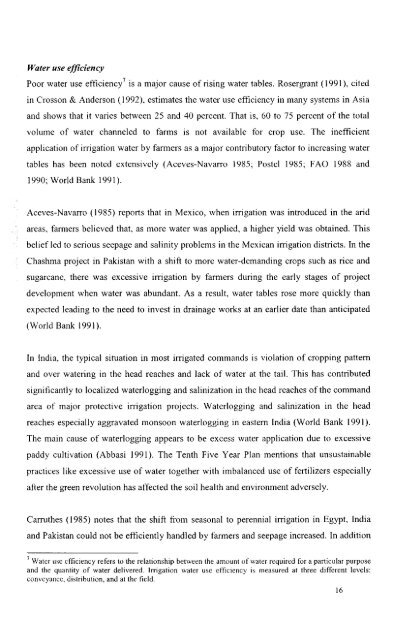Water Users Association and Irrigation Management - Institute for ...
Water Users Association and Irrigation Management - Institute for ...
Water Users Association and Irrigation Management - Institute for ...
You also want an ePaper? Increase the reach of your titles
YUMPU automatically turns print PDFs into web optimized ePapers that Google loves.
<strong>Water</strong> use efficiency<br />
Poor water use efficienc/ is a major cause of rising water tables. Rosergrant (1991), cited<br />
in Crosson & Anderson (1992), estimates the water use efficiency in many systems in Asia<br />
<strong>and</strong> shows that it varies between 25 <strong>and</strong> 40 percent. That is, 60 to 75 percent of the total<br />
volume of water channeled to farms is not available <strong>for</strong> crop use. The inefficient<br />
application of irrigation water by farmers as a major contributory factor to increasing water<br />
tables has been noted extensively (Aceves-Navarro 1985; Postel 1985; FAO 1988 <strong>and</strong><br />
1990; World Bank 1991).<br />
Aceves-Navarro (1985) reports that in Mexico, when irrigation was introduced in the arid<br />
areas, fanners believed that, as more water was applied, a higher yield was obtained. This<br />
belief led to serious seepage <strong>and</strong> salinity problems in the Mexican irrigation districts. In the<br />
Chashma project in Pakistan with a shift to more water-dem<strong>and</strong>ing crops such as rice <strong>and</strong><br />
sugarcane, there was excessive irrigation by farmers during the early stages of project<br />
development when water was abundant. As a result, water tables rose more quickly than<br />
expected leading to the need to invest in drainage works at an earlier date than anticipated<br />
(World Bank 1991).<br />
In India, the typical situation in most irrigated comm<strong>and</strong>s is violation of cropping pattern<br />
<strong>and</strong> over watering in the head reaches <strong>and</strong> lack of water at the tail. This has contributed<br />
significantly to localized waterlogging <strong>and</strong> salinization in the head reaches of the comm<strong>and</strong><br />
area of major protective irrigation projects. <strong>Water</strong>logging <strong>and</strong> salinization in the head<br />
reaches especially aggravated monsoon waterlogging in eastern India (World Bank 1991).<br />
The main cause of waterlogging appears to be excess water application due to excessive<br />
paddy cultivation (Abbasi 1991). The Tenth Five Year Plan mentions that unsustainable<br />
practices like excessive use of water together with imbalanced use of fertilizers especially<br />
after the green revolution has affected the soil health <strong>and</strong> environment adversely.<br />
Carruthes (1985) notes that the shift from seasonal to perennial irrigation in Egypt, India<br />
<strong>and</strong> Pakistan could not be efficiently h<strong>and</strong>led by farmers <strong>and</strong> seepage increased. In addition<br />
7 <strong>Water</strong> usc efficiency refers to the relationship between the amount of water required <strong>for</strong> a particular purpose<br />
<strong>and</strong> the quantity of water delivered. <strong>Irrigation</strong> water use et11ciency is measured at three different levels:<br />
conveyance, distribution, <strong>and</strong> at the field.<br />
16
















